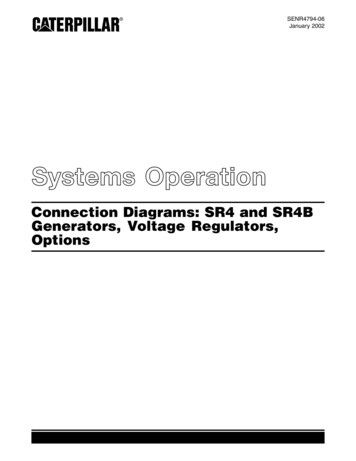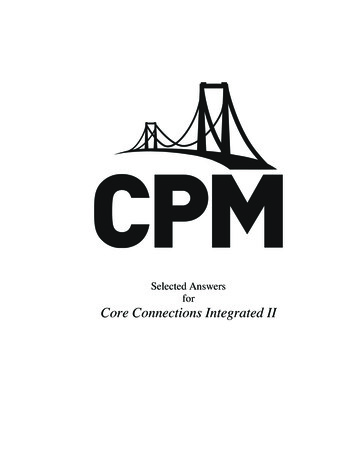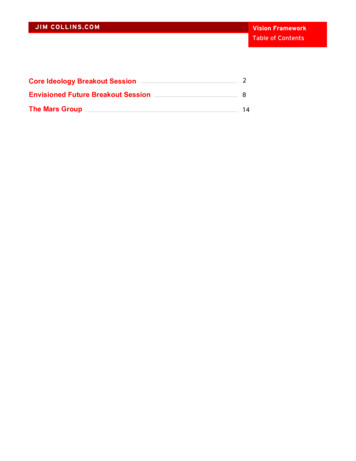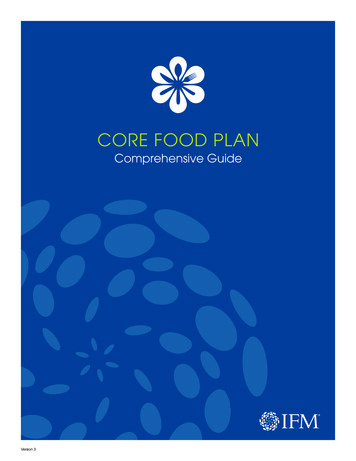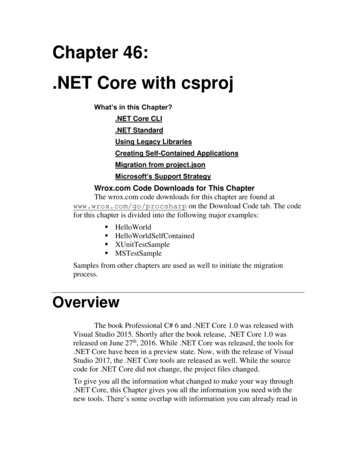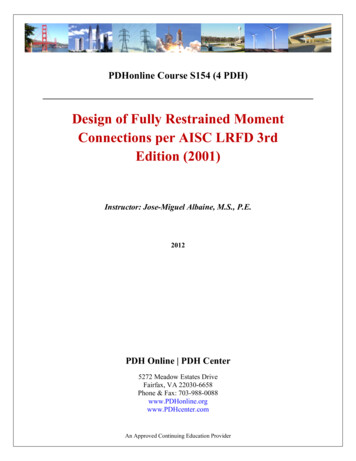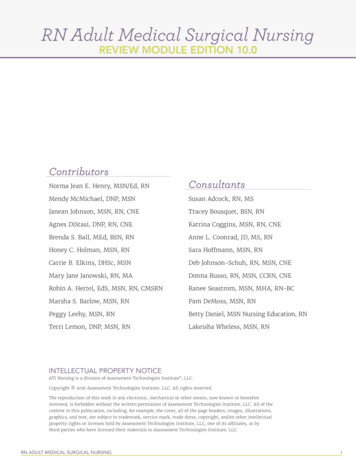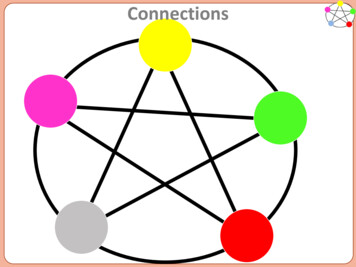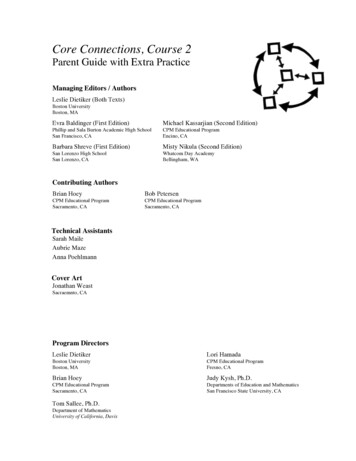
Transcription
Core Connections, Course 2Parent Guide with Extra PracticeManaging Editors / AuthorsLeslie Dietiker (Both Texts)Boston UniversityBoston, MAEvra Baldinger (First Edition)Michael Kassarjian (Second Edition)Phillip and Sala Burton Academic High SchoolSan Francisco, CACPM Educational ProgramEncino, CABarbara Shreve (First Edition)Misty Nikula (Second Edition)San Lorenzo High SchoolSan Lorenzo, CAWhatcom Day AcademyBellingham, WAContributing AuthorsBrian HoeyBob PetersenCPM Educational ProgramSacramento, CACPM Educational ProgramSacramento, CATechnical AssistantsSarah MaileAubrie MazeAnna PoehlmannCover ArtJonathan WeastSacraemnto, CAProgram DirectorsLeslie DietikerLori HamadaBoston UniversityBoston, MACPM Educational ProgramFresno, CABrian HoeyJudy Kysh, Ph.D.CPM Educational ProgramSacramento, CADepartments of Education and MathematicsSan Francisco State University, CATom Sallee, Ph.D.Department of MathematicsUniversity of California, Davis
Based on Foundations for Algebra Parent Guide 2002and Foundations for Algebra Skill Builders 2003Heidi AckleyBev BrockhoffScott CoynerBrian HoeyRobert PetersenKristie SalleeSteve AckleyEllen CafferataSara EffenbeckJudy KyshEdwin ReedTom SalleeElizabeth BakerElizabeth CoynerWilliam FunkhouserKris PetersenStacy RockleinHoward WebbGrace ChenJanelle PetersenDavid TromblyZoe KemmerlingThu PhamErika WallenderTechnical AssistantsJennifer BuddenhagenBipasha MukherjeeBethany SorbelloEmily WheelisCopyright 2013 by CPM Educational Program. All rights reserved. No part of this publication maybe reproduced or transmitted in any form or by any means, electronic or mechanical, includingphotocopy, recording, or any information storage and retrieval system, without permission in writingfrom the publisher. Requests for permission should be made in writing to: CPM Educational Program,1233 Noonan Drive, Sacramento, CA 95822. Email: cpm@cpm.org.1 2 3 4 5 619 18 17 16 15 14 13Printed in the United States of AmericaISBN: 978-1-60328-093-8
Introduction to the Parent Guide with Extra PracticeWelcome to the Core Connections Parent Guide with Extra Practice. The purpose of this guide is toassist you should your child need help with homework or the ideas in the course. We believe all studentscan be successful in mathematics as long as they are willing to work and ask for help when they need it.We encourage you to contact your child’s teacher if your student has additional questions that this guidedoes not answer.These topics are: ratios and proportional relationships, number, geometry, statistics and probability,and expressions, equations, and functions. Secondly, each topic is referenced to the specific book andchapter in which the major development of the concept occurs. Detailed examples follow a summary ofthe concept or skill and include complete solutions. The examples are similar to the work your child hasdone in class. Additional problems, with answers, are provided for your child to try.There will be some topics that your child understands quickly and some concepts that may take longerto master. The big ideas of the course take time to learn. This means that students are not necessarilyexpected to master a concept when it is first introduced. When a topic is first introduced in the textbook,there will be several problems to do for practice. Succeeding lessons and homework assignments willcontinue to practice the concept or skill over weeks and months so that mastery will develop over time.Practice and discussion are required to understand mathematics. When your child comes to you with aquestion about a homework problem, often you may simply need to ask your child to read the problemand then ask what the problem is asking. Reading the problem aloud is often more effective than readingit silently. When you are working problems together, have your child talk about the problems. Then haveyour child practice on his/her own.Below is a list of additional questions to use when working with your child. These questions do notrefer to any particular concept or topic. Some questions may or may not be appropriate for someproblems. What have you tried? What steps did you take? What didn't work? Why didn't it work? What have you been doing in class or during this chapter that might be related to this problem? What does this word/phrase tell you? What do you know about this part of the problem? Explain what you know right now. What do you need to know to solve the problem? How did the members of your study team explain this problem in class? What important examples or ideas were highlighted by your teacher? Can you draw a diagram or sketch to help you? Which words are most important? Why? What is your guess/estimate/prediction? Is there a simpler, similar problem we can do first? How did you organize your information? Do you have a record of your work? Have you tried drawing a diagram, making a list, looking for a pattern, etc.?
If your student has made a start at the problem, try these questions. What do you think comes next? Why? What is still left to be done? Is that the only possible answer? Is that answer reasonable? How could you check your work and your answer? How could your method work for other problems?If you do not seem to be making any progress, you might try these questions. Let's look at your notebook, class notes, and Toolkit. Do you have them? Were you listening to your team members and teacher in class? What did they say? Did you use the class time working on the assignment? Show me what you did. Were the other members of your team having difficulty with this as well?Can you call your study partner or someone from your study team?This is certainly not a complete list; you will probably come up with some of your own questions asyou work through the problems with your child. Ask any question at all, even if it seems too simple toyou.To be successful in mathematics, students need to develop the ability to reason mathematically. To doso, students need to think about what they already know and then connect this knowledge to the new ideasthey are learning. Many students are not used to the idea that what they learned yesterday or last weekwill be connected to today’s lesson. Too often students do not have to do much thinking in schoolbecause they are usually just told what to do. When students understand that connecting prior learning tonew ideas is a normal part of their education, they will be more successful in this mathematics course(and any other course, for that matter). The student’s responsibilities for learning mathematics includethe following: Actively contributing in whole class and study team work and discussion. Completing (or at least attempting) all assigned problems and turning in assignmentsin a timely manner. Checking and correcting problems on assignments (usually with their study partner orstudy team) based on answers and solutions provided in class and online. Asking for help when needed from his or her study partner, study team, and/or teacher. Attempting to provide help when asked by other students. Taking notes and using his/her Toolkit when recommended by the teacher or the text. Keeping a well-organized notebook. Not distracting other students from the opportunity to learn.Assisting your child to understand and accept these responsibilities will help him or her to besuccessful in this course, develop mathematical reasoning, and form habits that will help her/him becomea life-long learner.Additional support for students and parents is provided at the CPM Homework Help site:http://www.cpm.org/students/homework/The website provides a variety of complete solutions, hints, and answers. Some problems refer backto other similar problems. The homework help is designed to assist students to be able to do the problemsbut not necessarily do the problems for them.
Table of Contents by CourseCore Connections, Course 2Chapter 1Lessons 1.1.2, 1.2.1 to 1.2.3Simple Probability1Lessons 1.1.3 and 1.1.4 Math Notes Measures of Central Tendency4Lesson 1.2.2 Math NoteChoosing a Scale7Lessons 1.2.4 and 1.2.5Equivalent Fractions10Lessons 1.2.6 and 1.2.8Operations with FractionsAddition and Subtraction of Fractions11Lesson 1.2.7Compound Probability and Counting MethodsCompound Probability13Lesson 2.1.1Diamond Problems16Lesson 2.1.1Operations with Decimals18Lessons 2.1.1 and 2.1.2Fraction–Decimal-Percent Equivalents21Lessons 2.2.1 to 2.2.3Operations with IntegersAddition of Integers24Lesson 2.2.4Operations with IntegersMultiplication and Division of Integers27Lessons 2.2.5 to 2.2.6Operations with FractionsMultiplication of Fractions29Lessons 3.1.1 and 3.1.2Order of Operations31Lessons 3.2.1, 3.2.2, and 3.2.5Operations with IntegersSubtraction of Integers34Lesson 3.2.4Operations with DecimalsMultiplying Decimals and Percents36Lesson 3.3.1Operations with Fractions:Division by Fractions38Lesson 3.3.3Properties of Addition and Multiplication41Chapter 2Chapter 3
Chapter 4Lessons 4.1.1 and 4.1.2Scaling Figures and Scale Factor43Lessons 4.2.1, 4.2.2, and 4.2.4Proportional Relationships45Lesson 4.2.3 and 4.2.4Rates and Unit Rates48Lesson 4.3.1Algebra Tiles and Perimeter50Lesson 4.3.1Combining Like Terms52Lesson 4.3.2Distributive Property54Lesson 4.3.3Simplifying Expressions (on an Expression Mat)57Lessons 5.1.1 and 5.1.2Percent Problems using Diagrams59Lessons 5.1.1 and 5.1.2Ratios61Lesson 5.2.3Independent and Dependent Events63Lessons 5.2.3 to 5.2.6Compound Probability and Counting Methods64Lessons 5.3.1 to 5.3.5Solving Word Problems (The 5-D Process)72Lessons 5.3.4 to 5.3.5Writing Equations for Word Problems(The 5-D Process)78Lessons 6.1.1 to 6.1.2Comparing Quantities (on an Expression Mat)82Lessons 6.1.3 to 6.1.4Graphing and Solving Inequalities85Lessons 6.2.1 to 6.2.7Solving Equations in Context88Lesson 7.1.1Distance, Rate, and Time91Lessons 7.1.2 to 7.1.3Scaling to Solve Percent and Other Problems93Lessons 7.1.4 to 7.1.6Equations with Fractional Coefficients96Lesson 7.1.7Percent Increase or Decrease98Lesson 7.1.8Simple Interest100Math Notes boxes in Section 7.1Graphical Representations of Data102Chapter 5Chapter 6Chapter 7
Chapter 8Lessons 8.3.1 to 8.3.4Naming Quadrilaterals and Angles104Lesson 8.3.2Angle Pair Relationships107Lessons 9.1.1 and 9.1.2Circles – Circumference and Area109Lesson 9.1.3Area of Polygons and Complex Figures112Lessons 9.2.1 to 9.2.4Prisms – Surface Area and Volume122Chapter 9
SIMPLE PROBABILITY1.1.2, 1.2.1 – 1.2.3Outcome: Any possible or actual result of the action considered, such as rolling a 5 on astandard number cube or getting tails when flipping a coin.Event: A desired (or successful) outcome or group of outcomes from an experiment, such asrolling an even number on a standard number cube.Sample space: All possible outcomes of a situation. For example, the sample space for flippinga coin is heads and tails; rolling a standard number cube has six possible outcomes (1, 2, 3, 4, 5,and 6).Probability: The likelihood that an event will occur. Probabilities may be written as fractions,decimals, or percents. An event that is guaranteed to happen has a probability of 1, or 100%. Anevent that has no chance of happening has a probability of 0, or 0%. Events that “might happen”have probabilities between 0 and 1 or between 0% and 100%. In general, the more likely anevent is to happen, the greater its probability.Experimental probability: The probability based on data collected in experiments.number of successful outcomes in the experimentExperimental probability total number of outcomes in the experimentTheoretical probability is a calculated probability based on the possible outcomes when they allhave the same chance of occurring.Theoretical probability number of successful outcomes (events)total number of possible outcomesIn the context of probability, “successful” usually means a desired or specified outcome (event),such as rolling a 2 on a number cube (probability of 16 ). To calculate the probability of rolling a2, first figure out how many possible outcomes there are. Since there are six faces on the numbercube, the number of possible outcomes is 6. Of the six faces, only one of the faces has a 2 on it.Thus, to find the probability of rolling a 2, you would write:P(2) number of ways to roll 2number of possible outcomesParent Guide with Extra Practice 16 . or 0.16 .or approximately 16.7%1
Example 1If you roll a fair, 6-sided number cube, what is P(3) , that is, the probability that you will roll a 3?Because the six sides are equally likely to come up, and there is only one 3, P(3) 16 .Example 2There are 12 marbles in a bag: 2 clear, 4 green, 5 yellow, and 1 blue. If one marble is chosenrandomly from the bag, what is the probability that it will be yellow?5 (yellow)5P(yellow) 12 (outcomes) 12Example 3Joe flipped a coin 50 times. When he recorded his tosses, his result was 30 heads and 20 tails.Joe’s activity provided data to calculate experimental probability for flipping a coin.a.What is the theoretical probability of Joe flipping heads?The theoretical probability is 50% or 12 , because there are only two possibilities (heads andtails), and each is equally likely to occur.b.What was the experimental probability of flipping a coin and getting heads based on Joe’sactivity?The experimental probability iswhen he flipped the coin.3050,35, or 60%. These are the results Joe actually gotExample 4Decide whether these statements describe theoretical or experimental probabilities.a.The chance of rolling a 6 on a fair die is16.This statement is theoretical.b.I rolled the die 12 times and 5 came up three times.This statement is experimental.c.There are 15 marbles in a bag; 5 blue, 6 yellow, and 4 green. The probability of getting ablue marble is 13 .This statement is theoretical.d.When Veronika pulled three marbles out of the bag she got 2 yellow and 1 blue, or2yellow, 13 blue.3This statement is experimental.2Core Connections, Course 2
Problems1.There are 24 crayons in a box: 5 black, 3 white, 7 red, 2 yellow, 3 blue, and 4 green.What is the probability of randomly choosing a green? Did you respond with anexperimental or theoretical probability?2.A spinner is divided into four equal sections numbered 2, 4, 6, and 8. What is theprobability of spinning an 8?3.A fair number cube marked 1, 2, 3, 4, 5, and 6 is rolled. Tyler tossed the cube 40 times,and noted that 26 times an even number showed. What is the experimental probability thatan even number will be rolled? What is the theoretical probability?4.Sara is at a picnic and reaches into an ice chest, without looking, to grab a can of soda.If there are 14 cans of orange, 12 cans of fruit punch, and 10 cans of cola, what is theprobability that she takes a can of fruit punch? Did you respond with an experimentalprobability or a theoretical one?5.A baseball batting average is the probability a baseball player hits the ball when batting. Ifa baseball player has a batting average of 266, it means the player’s probability of gettingof getting a hit is 0.266. Is a batting average an experimental probability or theoretical?6.In 2011, 39 people died by being struck by lightning, and 241 people were injured. Therewere 310,000,000 people in the United States. What is the probability of being one of thepeople struck by lightning?7.In a medical study, 107 people were given a new vitamin pill. If a participant got sick, theywere removed from the study. Ten of the participants caught a common cold, 2 came downwith the flu, 18 got sick to their stomach, and 77 never got sick. What was the probabilityof getting sick if you participated in this study? Did you respond with an experimentalprobability or a theoretical one?8.Insurance companies use probabilities to determine the rate they will charge for aninsurance policy. In a study of 300 people that had life insurance policies, an insurancecompany found that 111 people were over 80 years old when they died, 82 people diedwhen they were between 70 and 80 years old, 52 died between 60 and 70 years old, and 55died when they were younger than 60 years old. In this study what was the probability ofdying younger than 70 years old? Did you respond with an experimental probability or atheoretical one?Answers1.5.16; theoreticalexperimental2.143.6.39 241310,000,0007.! 0.000 000 903Parent Guide with Extra Practice26 ; 340 6! 0.28experimental10 2 181074.8.13;theoretical! 35.7%experimental55 523003
MEASURES OF CENTRAL TENDENCY1.1.3 and 1.1.4 Math NotesMeasures of central tendency are numbers that locate or approximate the “center” of a set ofdata—that is, a “typical” value that describes the set of data. Mean and median are the mostcommon measures of central tendency. (Mode will not be covered in this course.)The mean is the arithmetic average of a data set. Add all the values in a set and divide thissum by the number of values in the set. The median is the middle number in a set of dataarranged numerically. An outlier is a number that is much smaller or larger than most of theothers in the data set. The range of a data set is the difference between the highest andlowest values of the data set.For additional information, see the Math Notes boxes in Lessons 1.1.3 and 1.1.4 of the CoreConnections, Course 2 text.The mean is calculated by finding the sum of the data set and dividing it by the number ofelements in the set.Example 1Example 2Find the mean of this set of data: 34, 31, 37,44, 38, 34, 42, 34, 43, and 41.Find the mean of this set of data: 92, 82, 80,92, 78, 75, 95, and 77. 34 31 37 44 38 34 42 34 43 41 378 37810 37.8The mean of this set of data is 37.8. 92 82 80 92 78 75 95 77 77 748 7489 83.1The mean of this set of data is 83.1.ProblemsFind the mean of each set of data.1.29, 28, 34, 30, 33, 26, and 34.2.25, 34, 35, 27, 31, and 30.3.80, 89, 79, 84, 95, 79, 78, 89, 76, 82,76, 92, 89, 81, and 123.4.116, 104, 101, 111, 100, 107, 113, 118,113, 101, 108, 109, 105, 103, and 91.4Core Connections, Course 2
The median is the middle number in a set of data arranged in numerical order. If there is aneven number of values, the median is the mean (average) of the two middle numbers.Example 3Example 4Find the median of this set of data: 34, 31, 37,44, 38, 34, 43, and 41.Find the median of this set of data: 92, 82, 80,92, 78, 75, 95, 77, and 77. Arrange the data in order: 31, 34, 34, 34,37, 38, 41, 43, 44. Arrange the data in order: 75, 77, 77, 78,80, 82, 92, 92, and 95. Find the middle value(s): 37 and 38. Since there are two middle values, find 37.5 .their mean: 37 38 75,! 752Therefore, the median of this data set is37.5.Find the middle value(s): 80. Therefore,the median of this data set is 80.ProblemsFind median of each set of data.5.29, 28, 34, 30, 33, 26, and 34.6.25, 34, 27, 25, 31, and 30.7.80, 89, 79, 84, 95, 79, 78, 89, 76, 82, 76,92, 89, 81, and 123.8.116, 104, 101, 111, 100, 107, 113, 118,113, 101, 108, 109, 105, 103, and 91.The range of a set of data is the difference between the highest value and the lowest value.Example 5Example 6Find the range of this set of data: 114, 109,131, 96, 140, and 128.Find the range of this set of data: 37, 44, 36,29, 78, 15, 57, 54, 63, 27, and 48. The highest value is 140. The highest value is 78. The lowest value is 96. The lowest value is 27. 140 ! 96 44 . 78 ! 27 51 . The range of this set of data is 44. The range of this set of data is 51.Parent Guide with Extra Practice5
ProblemsFind the range of each set of data in problems 5 through 8.Outliers are numbers in a data set that are either much higher or much lower that the othernumbers in the set.Example 7Example 8Find the outlier of this set of data: 88, 90 96,93, 87, 12, 85, and 94.Find the outlier of this set of data: 67, 54, 49,76, 64, 59, 60, 72, 123, 44, and 66. The outlier is 12. The outlier is 123.ProblemsIdentify the outlier in each set of data.9.70, 77, 75, 68, 98, 70, 72, and 71.10. 14, 22, 17, 61, 20, 16, and 15.11. 1376, 1645, 1783, 1455, 3754, 1790,1384, 1643, 1492, and 1776.12. 62, 65, 93, 51, 55, 14, 79, 85, 55, 72, 78,83, 91, and 76.Answers1.30.572.30.33.86.134.106.65.median 30;range 86.median 28.5;range 97.median 82;range 478.median 107;range 279.9810.6111.375412.146Core Connections, Course 2
CHOOSING A SCALE1.2.2 Math NoteThe axis (or axes) of a graph must be marked with equal-sized spaces called intervals. Markingthe uniform intervals on the axes is called scaling the axes. The difference between consecutivemarkings tells the size (scale) of each interval. Note that each axis of a two-dimensional graphmay use a different scale.Sometimes the axis or set of axes is not provided. A student must count the number of usablespaces on the graph paper. How many spaces are usable depends in part on how large the graphwill be and how much space will be needed for labeling beside each axis.Follow these steps to scale each axis of a graph.1. Find the difference between the smallest and largest numbers (the range) you need toput on an axis.2. Count the number of intervals (spaces) you have on your axis.3. Divide the range by the number of intervals to find the interval size.4. Label the marks on the axis using the interval size.Sometimes dividing the range by the number of intervals produces an interval size that makes itdifficult to interpret the location of points on the graph. The student may then exercise judgmentand round the interval size up (always up, if rounded at all) to a number that is convenient to use.Interval sizes like 1, 2, 5, 10, 20, 25, 50, 100, etc., work well. For more information, see theMath Notes box in Lesson 1.2.2 of the Core Connections, Course 2 text.Example 11. The difference between 0 and 60 is 60.2. The number line is divided into 5 equal intervals.3. 60 divided by 5 is 12.012243648604. The marks are labeled with multiples of the interval size 12.Example 23001. The difference between 300 and 0 is 300.2252. There are 4 intervals.1503. 300 4 754. The axis is labeled with multiples of 75.Parent Guide with Extra Practice7507
Example 37501. The difference on the vertical axis is 750 – 0 750. (Theorigin is (0, 0).) On the horizontal axis the range is 6 – 0 6.6004502. There are 5 spaces vertically and 3 spaces horizontally.3003. The vertical interval size is 750 5 150. The horizontalinterval is 6 3 2.1504. The axes are labeled appropriately.246Example 4Sometimes the axes extend in the negative direction.1. The range is 20 – (–15) 35.2. There are 7 intervals along the line.3.– 15 – 10–50510152035 7 54. Label the axes with multiples of five.ProblemsScale each �6–12Core Connections, Course 2
7.8.yy201610x9.x1210. Use fractions.yy2001300x1xAnswers1.2, 4, 6, 8, 10, 122.–9, –6, –3, 0, 3, 63.86, 102, 118, 1344.–2, 8, 18, 28, 385.–12, –11, –10, –9, –86.–20, –16, –14, –12, –10, –87.x: 2, 4, 6, 8, 12y: 4, 8, 12, 16, 248.x: 3, 6, 9, 15, 18y: 4, 8, 12, 20, 249.x: 60, 120, 180, 240, 360y: 40, 80, 120, 160, 24010.x :!! 14 , 12 , 43 , 1 14 , 1 12Parent Guide with Extra Practicey :!! 12 , 1 12 , 2, 2 12 , 39
EQUIVALENT FRACTIONS1.2.4 and 1.2.5Fractions that name the same value are called equivalent fractions, such as 23 69 .One method for finding equivalent fractions is to use the Multiplicative Identity (IdentityProperty of Multiplication), that is, multiplying the given fraction by a form of the number 1such as 22 , 55 , etc. In this course we call these fractions a “Giant One.” Multiplying by 1 doesnot change the value of a number.For additional information, see the Math Notes box in Lesson 1.2.8 of the Core Connections,Course 2 text.Example 1Find three equivalent fractions for1!22 2 241212.! 33 1!42 436 48Example 2Use the Giant One to find an equivalent fraction to712using 96ths:712!!!!!! ?96Which Giant One do you use?Since9612 8 , the Giant One is887 !812 8: 5696ProblemsUse the Giant One to find the specified equivalent fraction. Your answer should include theGiant One you use and the equivalent numerator.1.2.3.4.5.6.Answers1.1055, 202.44, 203.1919, 1714.44, 125.66, 306.3,318Core Connections, Course 2
OPERATIONS WITH FRACTIONS1.2.6 and 1.2.8ADDITION AND SUBTRACTION OF FRACTIONSBefore fractions can be added or subtracted, the fractions must have the same denominator, thatis, a common denominator. We will present two methods for adding or subtracting fractions.AREA MODEL METHODStep 1:Copy the problem.Step 2:Draw and divide equal-sized rectanglesfor each fraction. One rectangle is cutvertically into an equal number of piecesbased on the first denominator (bottom).The other is cut horizontally, using thesecond denominator. The number ofshaded pieces in each rectangle is basedon the numerator (top). Label eachrectangle, with the fraction it represents.Step 3:1 ! ! 132 13Superimpose the lines from eachrectangle onto the other rectangle, as ifone rectangle is placed on top of theother one.Step 4:Rename the fractions as sixths, becausethe new rectangles are divided into sixequal parts. Change the numerators tomatch the number of sixths in eachfigure.Step 5:Draw an empty rectangle with sixths,then combine all sixths by shading thesame number of sixths in the newrectangle as the total that were shaded inboth rectangles from the previous step.Parent Guide with Extra Practice12 26 365611
Example 1121 ! ! 225can be modeled as:5 410 10 510Thus,25so9104101 ! ! 2 ! ! 92510.Example 21 ! ! 425would be: 125104513 1 310 10810ProblemsUse the area model method to add the following fractions.1.3 ! ! 1452.1 ! ! 2373.2 ! ! 334Answers12Core Connections, Course 2
1.1920Parent Guide with Extra Practice2.13213.17125 1 1213
COMPOUND PROBABILITY AND COUNTING METHODS1.2.7COMPOUND PROBABILITYSometimes when you are finding a probability, you are interested in either of two outcomestaking place, but not both. For example, you may be interested in drawing a king or a queenfrom a deck of cards. At other times, you might be interested in one event followed by anotherevent. For example, you might want to roll a one on a number cube and then roll a six. Theprobabilities of combinations of simple events are called compound events.To find the probability of either one event or another event that has nothing in common with thefirst, you can find the probability of each event separately and then add their probabilities. Usingthe example above of drawing a king or a queen from a deck of cards:4 and P(queen) 4 so P(king or queen) 4 4 8 2P(king) 525252 525213For two independent events, to find the probability of both one and the other event occurring,you can find the probability of each event separately and then multiply their probabilities. Usingthe example of rolling a one followed by a six on a number cube:1P(1) 16 and P(6) 16 so P(1 then 6) 16 ! 16 36Note that you would carry out the same computation if you wanted to know the probability ofrolling a one on a green cube, and a six on a red cube, if you rolled both of them at the sametime.Example 1A spinner is divided into five equal sections numbered 1, 2, 3, 4, and 5. What is the probabilityof spinning either a 2 or a 5?Step 1:Determine both probabilities: P(2) Step 2:Since these are either-or compound events, add the fractions describing eachprobability: 15 15 2515The probability of spinning a 2 or a 5 is14and P(5) 2515: P(2 or 5) 25Core Connections, Course 2
Example 2If each of the regions in each spinnerat right is the same size, what is theprobability of spinning each spinner andgetting a green t-shirt?Step 1:Step 2:Determine both possibilities:P(green) 14 and P(t-shirt) whiteredgreenbluesweatert-shirtsweatshirt13Since you are interested in the compound event of both green and a t-shirt, multiply1both probabilities: 14 ! 13 12The probability of spinning a green t-shirt is112: P(green t-shirt) 112ProblemsAssume in each of the problems below that events are independent of each other.1.One die, numbered 1, 2, 3, 4, 5, and 6, is rolled. What is the probability of rolling either a1 or a 6?2.Mary is playing a game in which she rolls one die andspins a spinner. What is the probability she will get boththe 3 and black she needs to win the game? blueredblack3.A spinner is divided into eight equal sections. The sections are numbered 1, 2, 3, 4, 5, 6, 7,and 8. What is the probability of spinning a 2, 3, or a 4?4.Patty has a box of 12 colored pencils. There are 2 blue, 1 black, 1 gray, 3 red, 2 green,1 orange, 1 purple, and 1 yellow in the box. Patty closes her eyes and chooses one pencil.She is hoping to choose a green or a red. What is the probability she will get her wish?5.Use the spinners at right to tell Paul what his chances areof getting the silver truck he wants.scootertruckParent Guide with Extra Practicecarblueblacksilver15
6.On the way to school, the school bus must go through two traffic signals. The first light isgreen for 25 seconds out of each minute, and the second light is green for 35 seconds out ofeach minute. What is the probability that both lights will be green on the way to school?7.There are 250 students at South Lake Middle School. 125 enjoy swimming, 50 enjoyskateboarding, and 75 enjoy playing softball. What is the probability a student enjoys allthree sports?8.John has a bag of jellybeans. There are 100 beans in the bag. 14 of the beans are cherry,1of the beans are orange, 14 of the beans are licorice, and 14 of the beans are lemon.4What is the probability that John will chose one of his favorite flavors, orange, or cherry?9.A nationwide survey showed that only 4% of children liked eating lima beans. What is theprobability that any two children will both like lima beans?Answers1.264.5127.125 ! 50 ! 75250 250 25016or133 1002.1183.385.1126.25 ! 3560 608.249.116or12" 0.243Core Connections, Course 2
DIAMOND PROBLEMS2.1.1In every Diamond Problem, the product of the two side numbers (left and right)is the top number
Core Connections, Course 2 Chapter 1 Lessons 1.1.2, 1.2.1 to 1.2.3 Simple Probability 1 Lessons 1.1.3 and 1.1.4 Math Notes Measures of Central Tendency 4 Lesson 1.2.2 Math Note Choosing a Scale 7 Lessons 1.2.4 and 1.2.5 Equivalent Fractions 10 Lessons 1.2.6 and 1.2.8 Operation

